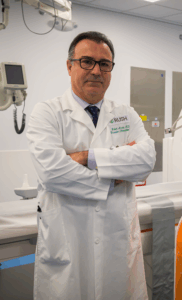
Results from the prospective, multicentre Liquid Embolization of Arterial Haemorrhages in Peripheral Vasculature (LAVA) study evaluating the Lava (Sirtex) ethylene vinyl alcohol (EVOH) liquid embolic have demonstrated a 94.3% primary effectiveness rate, exceeding a clinical performance goal of 72%.
“In the past five decades, many agents have been used in PAH [peripheral arterial haemorrhage], such as coils, plugs, particles, stent grafts, gelatine sponge, and liquid embolics,” write the study’s authors, led by Bulent Arslan (Rush University, Chicago, USA). Their paper, which was recently published in the Journal of Vascular and Interventional Radiology (JVIR), set out to identify whether liquid embolic agents could overcome some of the limitations of nonliquid agents. Liquid materials have been seen in some single-centre experiences to cause “near-complete, predictable, and permanent vessel occlusion, with reduced risk of incomplete occlusion due to coagulopathy and delayed recanalisation”, Arslan et al exposit.
The study included individuals aged 18 years or older with active haemorrhage in the peripheral vasculature, but no previous embolization in the target vessel and a life expectancy of more than 30 days. Enrolees were gained across 19 centres in the USA. PAH was defined as the presence of either active haemorrhage or pseudoaneurysm as diagnosed at endoscopy or catheter angiography or by computed tomography (CT) angiography.
Overall, 141 lesions were identified in 107 patients. Patients enrolled had a mean age of 57.4 years and 63.7% were male. Targeted areas included non-gastrointestinal visceral arteries (31.1%), kidneys (26.3%), upper gastrointestinal (GI) (11.5%), lower GI (6.8%), and extremities (6.1%). Arslan and colleagues describe that training was provided to all clinicians prior to the delivery of the EVOH agent. Ideally, the agent would be delivered via slow infusion not exceeding 0.3ml/ min from distal to proximal, with a gradual pull back to prevent catheter entrapment.
The primary effectiveness endpoint— clinical success at 30 days—was achieved in 133 of 141 lesions, and in 102 of 107 patients. Clinical success was defined as having satisfied four conditions: no bleeding from target lesion, no emergency surgery, no re-embolization, and no target esion reintervention.
Concerning procedural outcomes, adjunctive embolotherapy was used in 38 lesions. Bleeding following EVOH treatment was reported in nine lesions, while 144 lesions had “less bleeding” following the index procedure. Two target lesions treated with EVOH required subsequent re-embolization. A total of six (4.4%) adverse events occurred in five of 113 patients and the all-cause mortality rate at 30 days was reported as nine (8.3%) of 109—four patients exited the study before 30-day follow-up.
In a subgroup analysis, Arslan and colleagues add that clinical success was higher in males than in females, 98.9% and 86.3%, respectively, although major adverse event rate, technical success and intact retrieval of microcatheter rate at 30 days were similar between groups.
In their discussion, Arslan et al note that liquid embolic agents and mechanical occlusion devices can be “complementary” in certain settings, highlighting that 25.7% of treated lesions in their cohort required adjunctive embolics which were used concurrently with EVOH.
Although their study suggests that EVOH is safe and effective in PAH, the authors bring awareness to the diverse range of aetiologies and locations of bleed in their patient cohort which mean that their results cannot be generalised to a population that does not parallel the study’s population.
“The low rate of adverse events noted with EVOH is encouraging,” Aslan and colleagues write. “As with other liquid agents, the successful use of this device is associated with a short but steep learning curve.” The authors reiterate that the clinicians each had experience treating lesions with EVOH, and warn that adverse events may be more common if the operator is not experienced with the liquid agent.
Arslan et al state that these data provide a “higher level of evidence” in support of embolization of PAH than those in prior studies, which work to expand treatment options for the potentially life-threatening condition.










